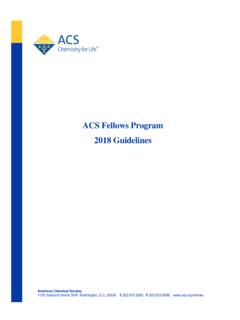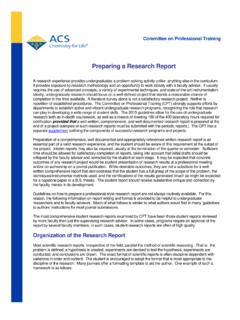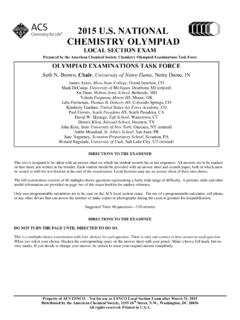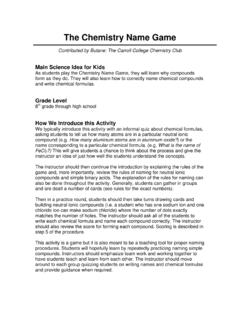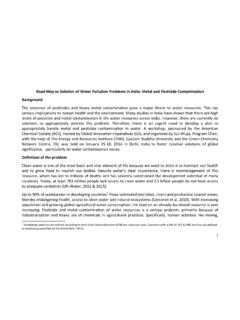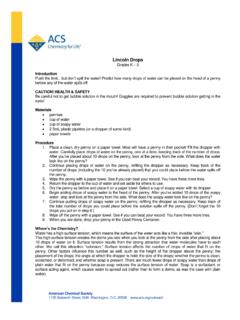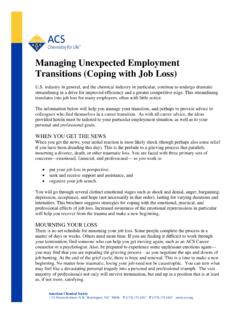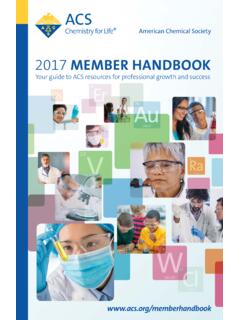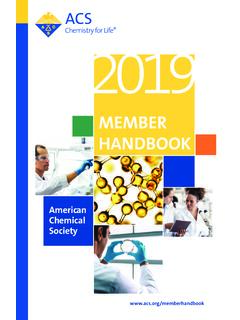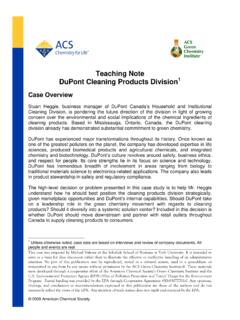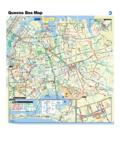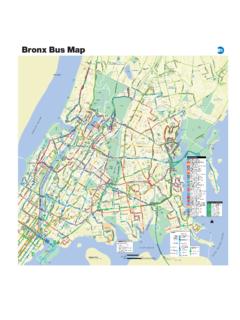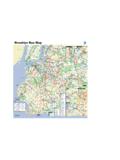Transcription of 2018 U.S. NATIONAL CHEMISTRY OLYMPIAD
1 Property of ACS USNCO Not for use as USNCO Local Section Exam after March 31, 2018 Distributed by the American Chemical Society, 1155 16th Street, , Washington, DC 20036 All rights reserved. Printed in 2018 NATIONAL CHEMISTRY OLYMPIAD LOCAL SECTION EXAM Prepared by the American Chemical Society CHEMISTRY OLYMPIAD Examinations Task Force OLYMPIAD EXAMINATIONS TASK FORCE Seth N. Brown, Chair, University of Notre Dame, Notre Dame, IN James Ayers, Colorado Mesa University, Grand Junction, CO Mark DeCamp, University of Michigan, Dearborn, MI (retired) Marian DeWane, Centennial High School, Boise, ID Xu Duan, Holton-Arms School, Bethesda, MD Valerie Ferguson, Moore HS, Moore, OK Julie Furstenau, Thomas B. Doherty HS, Colorado Springs, CO Kimberly Gardner, United States Air Force Academy, CO Paul Groves, South Pasadena HS, South Pasadena, CA Nicolas Hamel, Clackamas Community college , Oregon City, OR David W.
2 Hostage, Taft School, Watertown, CT John Kotz, State University of New York, Oneonta, NY (retired) Jane Nagurney, Scranton Preparatory School, Scranton, PA Sheila Nguyen, cypress college , cypress , CA Ronald Ragsdale, University of Utah, Salt Lake City, UT (retired) DIRECTIONS TO THE EXAMINER This test is designed to be taken with an answer sheet on which the student records his or her responses. All answers are to be marked on that sheet, not written in the booklet. Each student should be provided with an answer sheet and scratch paper, both of which must be turned in with the test booklet at the end of the examination. Local Sections may use an answer sheet of their own choice. The full examination consists of 60 multiple-choice questions representing a fairly wide range of difficulty. A periodic table and other useful information are provided on page two of this exam booklet for student reference.
3 Only non-programmable calculators are to be used on the ACS local section exam. The use of a programmable calculator, cell phone, or any other device that can access the internet or make copies or photographs during the exam is grounds for disqualification. Suggested Time: 60 questions 110 minutes DIRECTIONS TO THE EXAMINEE DO NOT TURN THE PAGE UNTIL DIRECTED TO DO SO. This is a multiple-choice examination with four choices for each question. There is only one correct or best answer to each question. When you select your choice, blacken the corresponding space on the answer sheet with your pencil. Make a heavy full mark, but no stray marks. If you decide to change your answer, be certain to erase your original answer completely. Page 2 Property of ACS USNCO Not for use as USNCO Local Section Exam after March 31, 2018 ABBREVIATIONS AND SYMBOLS CONSTANTS amount of substance n ampere A atmosphere atm atomic mass unit u Avogadro constant NA Celsius temperature C centi prefix c coulomb C density d electromotive force E energy of activation Ea enthalpy H entropy S equilibrium constant K Faraday constant F free energy G frequency gas constant R gram g hour h joule J kelvin K kilo prefix k liter L measure of pressure mm Hg milli prefix m molal m molar M molar mass M mole mol Planck s constant h pressure P rate constant k reaction quotient Q second s speed of light c temperature, K T time t vapor pressure VP volt V volume V R = J mol 1 K 1 R = L bar mol 1 K 1 F = 96,500 C mol 1 F = 96.
4 500 J V 1 mol 1 NA = 1023 mol 1 h = 10 34 J s c = 108 m s 1 0 C = K 1 atm = bar = 760 mm Hg Specific heat capacity of H2O = J g 1 K 1 EQUATIONS olnRTEEQnF o1lnconstantHKRT 211211lnaEkkR TT 1 PERIODIC TABLE OF THE ELEMENTS 18 1A 8A 1 H 2 13 14 15 16 17 2A 3A 4A 5A 6A 7A 2 He 3 Li 4 Be 5 B 6 C 7 N 8 O 9 F 10 Ne 11 Na 12 Mg 3 3B 4 4B 5 5B 6 6B 7 7B 8 8B 9 8B 10 8B 11 1B 12 2B 13 Al 14 Si 15 P 16 S 17 Cl 18 Ar 19 K 20 Ca 21 Sc 22 Ti 23 V 24 Cr 25 Mn 26 Fe 27 Co 28 Ni 29 Cu 30 Zn 31 Ga 32 Ge 33 As 34 Se 35 Br 36 Kr 37 Rb 38 Sr 39 Y 40 Zr 41 Nb 42 Mo 43 Tc (98) 44 Ru 45 Rh 46 Pd 47 Ag 48 Cd 49 In 50 Sn 51 Sb 52 Te 53 I 54 Xe 55 Cs 56 Ba 57 La 72 Hf 73 Ta 74 W 75 Re 76 Os 77 Ir 78 Pt 79 Au 80 Hg 81 Tl 82 Pb 83 Bi 84 Po (209) 85 At (210) 86 Rn (222) 87 Fr (223) 88 Ra (226) 89 Ac (227) 104 Rf (261) 105 Db (262) 106 Sg (263) 107 Bh (262) 108 Hs (265) 109 Mt (266) 110 Ds (281) 111 Rg (272) 112 Cn (285) 113 Nh (286) 114 Fl (289) 115 Mc (289) 116 Lv (293) 117 Ts (294) 118 Og (294) 58 Ce 59 Pr 60 Nd 61 Pm (145) 62 Sm 63 Eu 64 Gd 65 Tb 66 Dy 67 Ho 68 Er 69 Tm 70 Yb 71 Lu 90 Th 91 Pa 92 U 93 Np (237) 94 Pu (244) 95 Am (243) 96 Cm (247) 97 Bk (247) 98 Cf (251) 99 Es (252) 100 Fm (257) 101 Md (258) 102 No (259) 103 Lr (262)
5 Property of ACS USNCO Not for use as USNCO Local Section Exam after March 31, 2018 Page 3 Page 3 DIRECTIONS When you have selected your answer to each question, blacken the corresponding space on the answer sheet using a soft, #2 pencil. Make a heavy, full mark, but no stray marks. If you decide to change an answer, erase the unwanted mark very carefully. There is only one correct answer to each question. Any questions for which more than one response has been blackened will not be counted. Your score is based solely on the number of questions you answer correctly. It is to your advantage to answer every question. 1. How many oxygen atoms are in 225 g O2? (A) 1024 (B) 1024 (C) 1024 (D) 1025 2. A M solution of HCl is prepared by adding some M HCl to a 500 mL volumetric flask and diluting to the mark with deionized water.
6 What volume of M HCl must be added? (A) 100. mL (B) 150. mL (C) 225. mL (D) 250. mL 3. Copper(I) oxide, Cu2O, is reduced to metallic copper by heating in a stream of hydrogen gas. What mass of water is produced when g copper is formed? (A) g (B) g (C) g (D) g 4. The mineral enargite is Cu, As, and S by mass. What is the empirical formula of enargite? (A) CuAsS (B) Cu2 AsS2 (C) Cu3 AsS4 (D) Cu4 AsS3 5. A g sample of calcium nitrate (Ca(NO3)2, M = 164) contaminated with silica (SiO2, M = ) is found to contain g calcium. What is the mass percent purity of calcium nitrate in the sample? (A) 20% (B) 24% (C) 73% (D) 82% 6. A solution of g of which hydrated salt dissolved in 200 g H2O will have the lowest freezing point? (A) CuSO4 5 H2O (M = 250) (B) NiSO4 6 H2O (M = 263) (C) MgSO4 7 H2O (M = 246) (D) Na2SO4 10 H2O (M = 286) 7.
7 Addition of 6 M HCl to which substance will NOT result in gas evolution? (A) Al (B) Zn (C) K2CO3 (D) NaNO3 8. A divalent metal ion dissolved in dilute hydrochloric acid forms a precipitate when H2S is bubbled through the solution. Which ion is it? (A) Ca2+ (B) Mn2+ (C) Zn2+ (D) Cd2+ 9. Which compound will form the most intensely colored M aqueous solution? (A) KMnO4 (B) KClO4 (C) KAl(SO4)2 (D) KI 10. A solution contains M Sr2+ ions and M Ag+ ions. Addition of an equal volume of a M solution of which reagent will cause precipitation of a strontium salt but not a silver salt? (A) NaNO3 (B) NaF (C) NaOH (D) NaCl 11. Which would be most suitable for measuring mL of ethanol for addition to a reaction with acidified dichromate? (A) 10-mL graduated cylinder (B) 10-mL volumetric flask (C) 10-mL volumetric pipet (D) 10-mL beaker 12.
8 The molar mass of a solid carboxylic acid is determined by titrating a known mass of the acid with a standardized solution of NaOH to a phenolphthalein endpoint. Which errors will lead to a molar mass that is smaller than the actual molar mass? I. Some of the acid is spilled when being transferred into the titration flask. II. The endpoint is recorded when the solution is dark red in color rather than light pink. (A) I only (B) II only (C) Both I and II (D) Neither I nor II Page 4 Property of ACS USNCO Not for use as USNCO Local Section Exam after March 31, 2018 13. What state of matter corresponds to the diagram below? (A) Gas (B) Liquid (C) Amorphous solid (D) Crystalline solid 14. The normal boiling point of 2-propanol, (CH3)2 CHOH, is 83 C, while that of acetone, (CH3)2C=O, is 56 C. What is the principal reason for the greater boiling point of 2-propanol?
9 (A) The O H bond in 2-propanol is stronger than the C H bonds in acetone. (B) 2-Propanol experiences greater London dispersion forces than acetone. (C) 2-Propanol experiences stronger dipole-dipole interactions than acetone. (D) 2-Propanol experiences stronger hydrogen bonding than acetone. 15. Consider the four gases CO2, N2, CCl4, and He. Which is the correct order of increasing average molecular speed at 100 C? (A) He < N2 < CO2 < CCl4 (B) CCl4 < CO2 < N2 < He (C) He < CO2 < N2 < CCl4 (D) CCl4 < N2 < CO2 < He 16. Under what conditions will the behavior of a real gas best approximate the behavior of an ideal gas? I. High temperature II. High pressure (A) I only (B) II only (C) Both I and II (D) Neither I nor II 17. A solid has a melting point of 1710 C, is soluble in water, and does not conduct electricity in the solid state.
10 What is the most likely nature of the bonding in this solid? (A) Molecular covalent (B) Network covalent (C) Ionic (D) Metallic 18. Toluene, C7H8, has both a higher vapor pressure than water at 25 C and a higher normal boiling point. Which statement best explains these observations? (A) Liquids with higher vapor pressures typically have higher boiling points. (B) Toluene has a higher molar mass than water. (C) Toluene has a lower heat of vaporization than water. (D) The density of toluene vapor is greater than that of water vapor. 19. To g water at C in a well-insulated container is added a block of aluminum initially at C. The temperature of the water once the system reaches thermal equilibrium is C. What is the mass of the aluminum block? (The specific heat capacity of Al is J g 1 K 1.) (A) g (B) g (C) g (D) 130.
